Ultra-Wideband Diversity MIMO Antenna System for Future Mobile Handsets
Abstract
1. Introduction
2. Dual-Polarized UWB Slot Antenna
3. The Proposed UWB Diversity Antenna System
- for i,j = 1,…,8
4. Conclusions
Author Contributions
Funding
Acknowledgments
Conflicts of Interest
References
- Song, Y.; Guo, N.; Qiu, R.C. Towards a real-time UWB MIMO test bed for sensing and communications. Proc. IEEE Southeastcon. 2011, 59–63. [Google Scholar]
- Federal Communication Commission. First Report and order Revision of part 15 of the Commission’s Rules Regarding Ultrawideband Transmission System; Federal Communication Commission: Washington, DC, USA, 2002.
- Chandel, R.; Gautam, A.K.; Rambabu, K. Design and packaging of an eye-shaped multiple-input–multiple-output antenna with high isolation for wireless UWB applications. IEEE Trans. Compon. Packag. Manuf. Technol. 2018, 8, 635–642. [Google Scholar] [CrossRef]
- Mazloum, J.; Ghorashi, S.A.; Ojaroudi, M.; Ojaroudi, N. Compact triple-band S-shaped monopole diversity antenna for MIMO applications. Appl. Comput. Electromagn. Soc. J. 2015, 30, 975–980. [Google Scholar]
- Rajagopalan, A.; Gupta, G.; Konanur, A.S.; Hughes, B.; Lazzi, G. Increasing channel capacity of an ultrawideband MIMO system using vector antennas. IEEE Trans. Antennas Propag. 2007, 55, 2880–2887. [Google Scholar] [CrossRef]
- Ojaroudi, N.; Ghadimi, N. Dual-band CPW-fed slot antenna for LTE and WiBro applications. Microw. Opt. Technol. Lett. 2014, 56, 1013–1015. [Google Scholar] [CrossRef]
- Zhang, R.; Song, L.; Jaiprakash, A.; Talty, T.; Alanazi, A.; Alghafis, A.; Tonguz, O. Using ultra-wideband technology in vehicles for infrastructure-free localization. arXiv 2019, arXiv:1902.07764. [Google Scholar]
- Mearian, L. Ultra Wideband (UWB) Explained (and Why It’s in the iPhone 11). Available online: https://www.computerworld.com/article/3490037 (accessed on 31 December 2019).
- Swedberg, C. Mobile phone companies to demonstrate UWB payments. RFID J. 2020. [Google Scholar]
- Rao, Q.; Wilson, K. Design, modeling, and evaluation of a multiband MIMO/diversity antenna system for small wireless mobile terminals. IEEE Trans. Compon. Packag. Manuf. Technol. 2011, 59, 410–419. [Google Scholar] [CrossRef]
- Jensen, M.; Wallace, J. A review of antennas and propagation for MIMO wireless communications. IEEE Trans. Antennas Propag. 2004, 52, 2810–2824. [Google Scholar] [CrossRef]
- Larsson, E. Massive MIMO for next generation wireless Systems. IEEE Commun. Mag. 2014, 52, 186–195. [Google Scholar] [CrossRef]
- Parchin, N.O.; Basherlou, H.J.; Al-Yasir, Y.I.; Abdulkhaleq, A.M.; Abd-Alhameed, R.A.; Excell, P.S. Eight-port MIMO antenna system for 2.6 GHz LTE cellular communications. Progress Electromagn. Res. C 2020, 99, 49–59. [Google Scholar] [CrossRef][Green Version]
- Al-Yasir, Y.I.A.; Abdullah, A.S.; Ojaroudi Parchin, N.; Abd-Alhameed, R.A.; Noras, J.M. A new polarization-reconfigurable antenna for 5G applications. Electronics 2018, 7, 293. [Google Scholar] [CrossRef]
- Ojaroudiparchin, N.; Shen, M.; Pedersen, G.F. Small-size tapered slot antenna (TSA) design for use in 5G phased array applications. Appl. Comput. Electromagn. Soc. J. 2018, 32, 193–202. [Google Scholar]
- Zhang, Z. Antenna Design for Mobile Devices; Wiley-IEEE Press: Hoboken, NJ, USA, 2011. [Google Scholar]
- Ojaroudi, N. Circular microstrip antenna with dual band-stop performance for ultra-wideband systems. Microw. Opt. Technol. Lett. 2014, 56, 2095–2098. [Google Scholar] [CrossRef]
- Ojaroudi, N. Design of microstrip antenna for 2.4/5.8 GHz RFID applications. In Proceedings of the GeMic 2014, German Microwave Conference, RWTH Aachen University, Aachen, Germany, 10–12 March 2014. [Google Scholar]
- Valizade, A.; Ghobadi, C.; Nourinia, J.; Ojaroudi, N.; Ojaroudi, M. Band-notch slot antenna with enhanced bandwidth by using Ω-shaped strips protruded inside rectangular slots for UWB applications. Appl. Comput. Electromagn. Soc. (ACES) J. 2012, 27, 816–822. [Google Scholar]
- Ojaroudi, Y.; Ojaroudi, N.; Ghadimi, N. Circularly polarized microstrip slot antenna with a pair of spur-shaped slits for WLAN applications. Microw. Opt. Technol. Lett. 2015, 57, 756–759. [Google Scholar] [CrossRef]
- Zhao, X.; Yeo, S.P.; Ong, L.C. Decoupling of inverted-F antennas with high-order modes of ground plane for 5G mobile MIMO platform. IEEE Trans. Antennas Propag. 2018, 66, 4485–4495. [Google Scholar] [CrossRef]
- Wong, K.-L.; Lu, J.-Y.; Chen, L.-Y.; Li, W.Y.; Ban, Y.L. 8-antenna and 16-antenna arrays using the quad-antenna linear array as a building block for the 3.5-GHz LTE MIMO operation in the smartphone. Microw. Opt. Technol. Lett. 2016, 58, 174–181. [Google Scholar] [CrossRef]
- Sun, L.; Feng, H.; Li, Y.; Zhang, Z. Compact 5G MIMO mobile phone antennas with tightly arranged orthogonal-mode pairs. IEEE Trans. Antennas Propag. 2018, 66, 6364–6369. [Google Scholar] [CrossRef]
- Abdullah, M.; Ban, Y.L.; Kang, K.; Li, M.Y.; Amin, M. Eight-element antenna array at 3.5GHz for MIMO wireless application. Progress Electromagn. Res. C 2017, 78, 209–217. [Google Scholar] [CrossRef]
- Parchin, N.O.; Al-Yasir, Y.I.; Basherlou, H.J.; Abd-Alhameed, R.A.; Noras, J.M. Orthogonally dual-polarised MIMO antenna array with pattern diversity for use in 5G smartphones. IET Microw. Antennas Propag. 2020. [Google Scholar]
- Li, M.-Y. Eight-port orthogonally dual-polarised MIMO antennas using loop structures for 5G smartphone. IET Microw. Antennas Propag. 2017, 11, 1810–1816. [Google Scholar] [CrossRef]
- Parchin, N.O.; Al-Yasir, Y.I.; Noras, J.M.; Abd-Alhameed, R.A. Dual-polarized MIMO antenna array design using miniaturized self-complementary structures for 5G smartphone applications. In Proceedings of the 13th European Conference on Antennas and Propagation (EuCAP), Krakow, Poland, 31 March–5 April 2019. [Google Scholar]
- Li, M.-Y.; Ban, Y.L.; Xu, Z.Q.; Wu, G.; Kang, K.; Yu, Z.F. Eight-port orthogonally dual-polarized antenna array for 5G smartphone applications. IEEE Trans. Antennas Propag. 2016, 64, 3820–3830. [Google Scholar] [CrossRef]
- Parchin, N.O.; Al-Yasir, Y.I.A.; Ali, A.H.; Elfergani, I.; Noras, J.M.; Rodriguez, J.; Abd-Alhameed, R.A. Eight-element dual-polarized MIMO slot antenna system for 5G smartphone applications. IEEE Access 2019, 9, 15612–15622. [Google Scholar] [CrossRef]
- Parchin, N.O.; Al-Yasir, Y.I.; Basherlou, H.J.; Abdulkhaleq, A.M.; Sajedin, M.; Abd-Alhameed, R.A.; Noras, J.M. Modified PIFA array design with improved bandwidth and isolation for 5G mobile handsets. In Proceedings of the 2019 IEEE 2nd 5G World Forum (5GWF), Dresedn, Germany, 30 September–2 October 2019. [Google Scholar]
- Xu, S.; Zhang, M.; Wen, H.; Wang, J. Deep-subwavelength decoupling for MIMO antennas in mobile handsets with singular medium. Sci. Rep. 2017, 7, 12162. [Google Scholar] [CrossRef]
- Al-Hadi, A.A.; Ilvonen, J.; Valkonen, R.; Viikan, V. Eight-element antenna array for diversity and MIMO mobile terminal in LTE 3500MHz band. Microwave Opt. Technol. Lett. 2014, 56, 1323–1327. [Google Scholar] [CrossRef]
- Zhao, A.; Zhouyou, R. Size reduction of self-isolated MIMO antenna system for 5G mobile phone applications. IEEE Antennas Wirel. Propag. Lett. 2019, 18, 152–156. [Google Scholar] [CrossRef]
- Jiang, W.; Liu, B.; Cui, Y.; Hu, W. High-isolation Eight-Element MIMO array for 5G smartphone applications. IEEE Access 2019, 7, 34104–34112. [Google Scholar] [CrossRef]
- Zhekov, S.S.; Tatomirescu, A.; Franek, O.; Pedersen, G.F. Study of the interaction user head-ultrawideband MIMO antenna array for mobile terminals. Proc. Int. Conf. Electromagn. Adv. Appl. 2016, 930–933. [Google Scholar]
- Zhang, X.; Li, Y.; Wang, W.; Shen, W. Ultra-wideband 8-port MIMO antenna array for 5G metal-frame smartphones. IEEE Access 2019, 7, 72273–72282. [Google Scholar] [CrossRef]
- Zhao, A.; Ren, Z. Wideband MIMO antenna systems based on coupled-loop antenna for 5G N77/N78/N79 applications in mobile terminals. IEEE Access 2019, 7, 93761–93771. [Google Scholar] [CrossRef]
- Liu, D.Q.; Luo, H.J.; Zhang, M.; Wen, H.L.; Wang, B.; Wang, J. An extremely low-profile wideband MIMO antenna for 5G smart-phones. IEEE Trans. Antennas Propag. 2019, 67, 5772–5780. [Google Scholar] [CrossRef]
- Kamalvand, A.; Ghobadi, C.; Nourinia, J.; Ojaroudi, M.; Ojaroudi, N. Omni-directional/multi-resonance CPW-fed small slot antenna for UWB applications. ACES J. 2013, 28, 829–835. [Google Scholar]
- Ojaroudi, N.; Ojaroudi, M.; Amiri, S. Enhanced bandwidth of small square monopole antenna by using inverted U-shaped slot and conductor-backed plane. Appl. Comput. Electromagn. Soc. (ACES) J. 2012, 27, 685–690. [Google Scholar] [CrossRef]
- Ojaroudi, N.; Ojaroudi, M.; Ghadimi, N. UWB omnidirectional square monopole antenna for use in circular cylindrical microwave imaging systems. IEEE Antennas Wireless Propag. Lett. 2012, 11, 1350–1353. [Google Scholar] [CrossRef]
- Dastranj, A. Optimization of a printed UWB antenna: Application of the invasive weed optimization algorithm in antenna design. IEEE Antennas Propag. Mag. 2017, 59, 48–57. [Google Scholar] [CrossRef]
- Sharawi, M.S. Printed MIMO Antenna Engineering; Artech House: Norwood, MA, USA, 2014. [Google Scholar]
- Parchin, N.O.; Jahanbakhsh Basherlou, H.; Al-Yasir, Y.I.; Abdulkhaleq, A.M.; Patwary, M.; Abd-Alhameed, R.A. A new CPW-fed diversity antenna for MIMO 5G smartphones. Electronics 2020, 9, 261. [Google Scholar] [CrossRef]
- Parchin, N.O.; Abd-Alhameed, R.A.; Shen, M. Gain improvement of a UWB antenna using a single-layer FSS. In Proceedings of the PhotonIcs & Electromagnetics Research Symposium (PIERS), Xiamen, China, 17–20 December 2019. [Google Scholar]
- Siahkal-Mahalle, B.H.; Ojaroudi, M.; Ojaroudi, N. Enhanced bandwidth small square monopole antenna with band-notched functions for UWB wireless communications. Appl. Comput. Electromagn. Soc. (ACES) J. 2012, 27, 759–765. [Google Scholar]
- Zhu, F.; Gao, S. Development and implementation of a dual-polarized slot-loaded patch antenna for ultra-wideband imaging systems. In Proceedings of the URSI General Assembly and Scientific Symposium (URSI GASS), Beijing, China, 16–23 August 2014. [Google Scholar]
- Zhu, F.; Gao, S.; Ho, A.T.; Abd-Alhameed, R.A.; See, C.H.; Brown, T.W.; Xu, J. Ultra-wideband dual-polarized patch antenna with four capacitively coupled feeds. IEEE Trans. Antennas Propag. 2014, 62, 2440–2449. [Google Scholar]
- Ram Krishnaa, R.V.S.; Kumar, R. Design and investigations of a microstrip fed open V-shape slot antenna for wideband dual slant polarization. Eng. Sci. Technol. Int. J. (JESTECH) 2015, 18, 513–523. [Google Scholar] [CrossRef][Green Version]
- Yahya, R.; Nakamura, A.; Itami, M.; Denidni, T.A. A novel UWB FSS-based polarization diversity antenna. IEEE Antennas Wirel. Propag. Lett. 2017, 16, 2525–2528. [Google Scholar] [CrossRef]
- Augustin, G.; Chacko, B.P.; Denidni, T.A. Dual Port Ultra Wideband Antennas for Cognitive Radio and Diversity Applications in Advancement in Microstrip Antennas with Recent Applications; InTech: Rijeka, Croatia, 2013. [Google Scholar]
- Kishna, R.V.R.; Kumar, R.; Kushwaha, N. An UWB dual polarized microstrip fed L-shape slot antenna. Int. J. Microw. Wireless Technol. 2016, 8, 363–368. [Google Scholar] [CrossRef]
- Ram Krishnaa, R.V.S.; Kumar, R. A dual-polarized square-ring slot antenna for UWB, imaging, and radar applications. IEEE Antennas Wireless Propag. Lett. 2016, 15, 195–198. [Google Scholar] [CrossRef]
- Xiong, L.; Gao, P. Compact dual-polarized slot UWB antenna with CPW-fed structure. Proc. IEEE Antennas Propag. Soc. Int. Symp. (APSURSI’12) 2012, 1–2. [Google Scholar]
- Irene, G.; Rajesh, A. A dual-polarized UWB–MIMO antenna with IEEE 802.11ac band-notched characteristics using split-ring resonator. J. Comput. Electron. 2018, 17, 1090–1098. [Google Scholar] [CrossRef]
- Zhu, J.; Li, S.; Feng, B.; Deng, L.; Yin, S. Compact dual polarized UWB quasi-self-complementary MIMO/diversity antenna with band-rejection capability. IEEE Antennas Wireless Propag. Lett. 2016, 15, 905–908. [Google Scholar] [CrossRef]
- Tiang, S.S.; Hathal, M.S.; Anwar, N.S.; Ain, M.F.; Abdullah, M.Z. Development of a compact wide-slot antenna for early stage breast cancer detection featuring circular array full-view geometry. Int. J. Antennas Propag. 2014, 1–11. [Google Scholar] [CrossRef]
- Ojaroudiparchin, N.; Shen, M.; Fr, G. Design of Vivaldi antenna array with end-fire beam steering function for 5G mobile terminals. In Proceedings of the 23rd Telecommunications Forum Telfor (TELFOR), Belgrade, Serbia, 24–26 November 2015; pp. 587–590. [Google Scholar]
- Parchin, N.O.; Jahanbakhsh Basherlou, H.; Al-Yasir, Y.I.; Ullah, A.; Abd-Alhameed, R.A.; Noras, J.M. ‘Multi-band MIMO antenna design with user-impact investigation for 4G and 5G mobile terminals. Sensors 2019, 19, 456. [Google Scholar] [CrossRef]
- Ojaroudiparchin, N.; Shen, M.; Zhang, S.; Pedersen, G.F. A switchable 3D-coverage phased array antenna package for 5G mobile terminals. IEEE Antennas Wirel. Propag. Lett. 2016, 15, 1747–1750. [Google Scholar] [CrossRef]
- Ojaroudi, N.; Ojaroudi, Y.; Ojaroudi, S. Compact ultra-wideband monopole antenna with enhanced bandwidth and dual band-stop properties. Int. J. RF Microw. Comput. Aided Eng. 2014, 25, 346–357. [Google Scholar] [CrossRef]
- Chang, L.; Yu, Y.; Wei, K.; Wang, H. Polarization-orthogonal co-frequency dual antenna pair suitable for 5G MIMO smartphone with metallic bezels. IEEE Trans. Antennas Propag. 2019, 67, 5212–5220. [Google Scholar] [CrossRef]


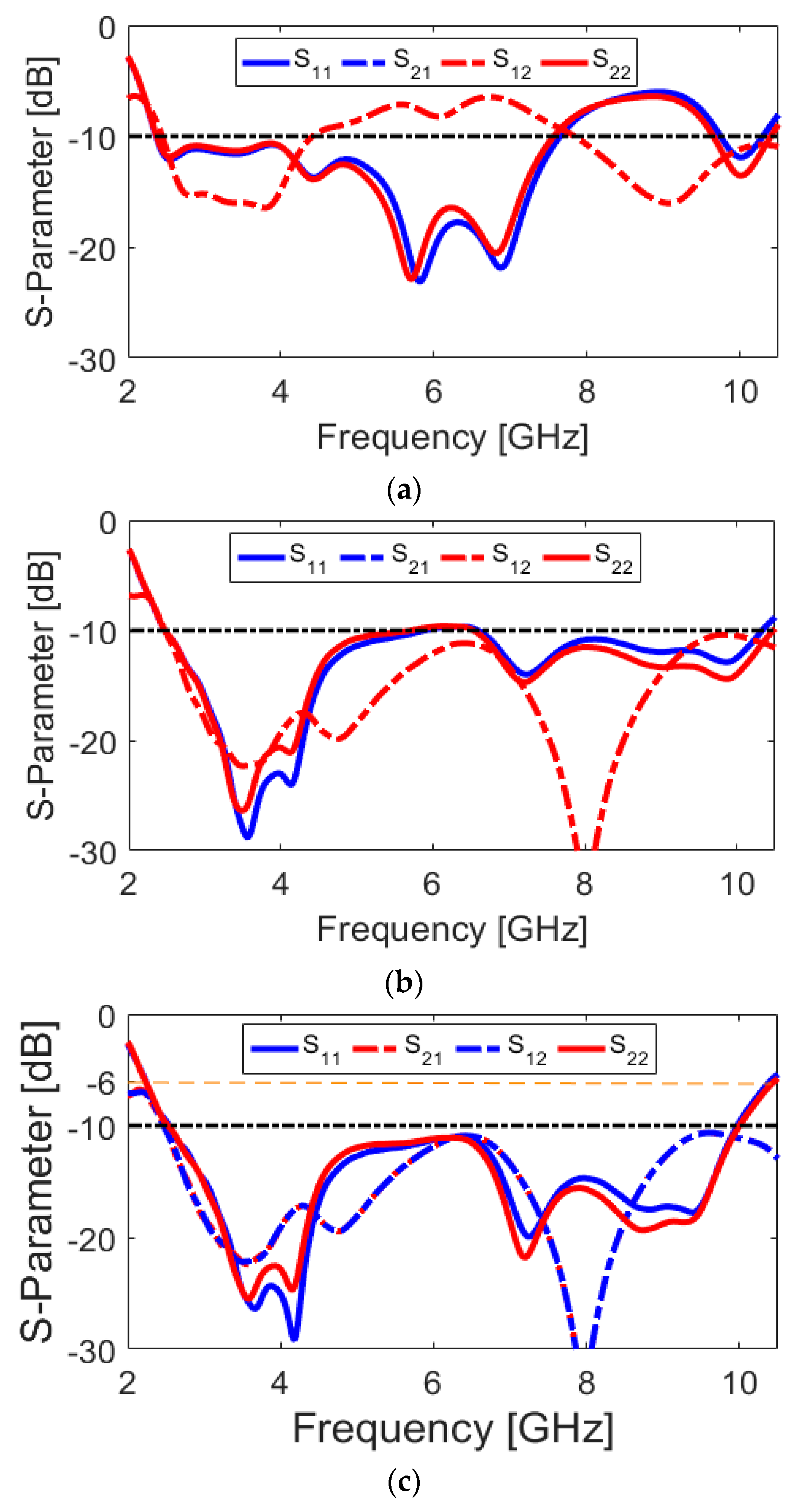
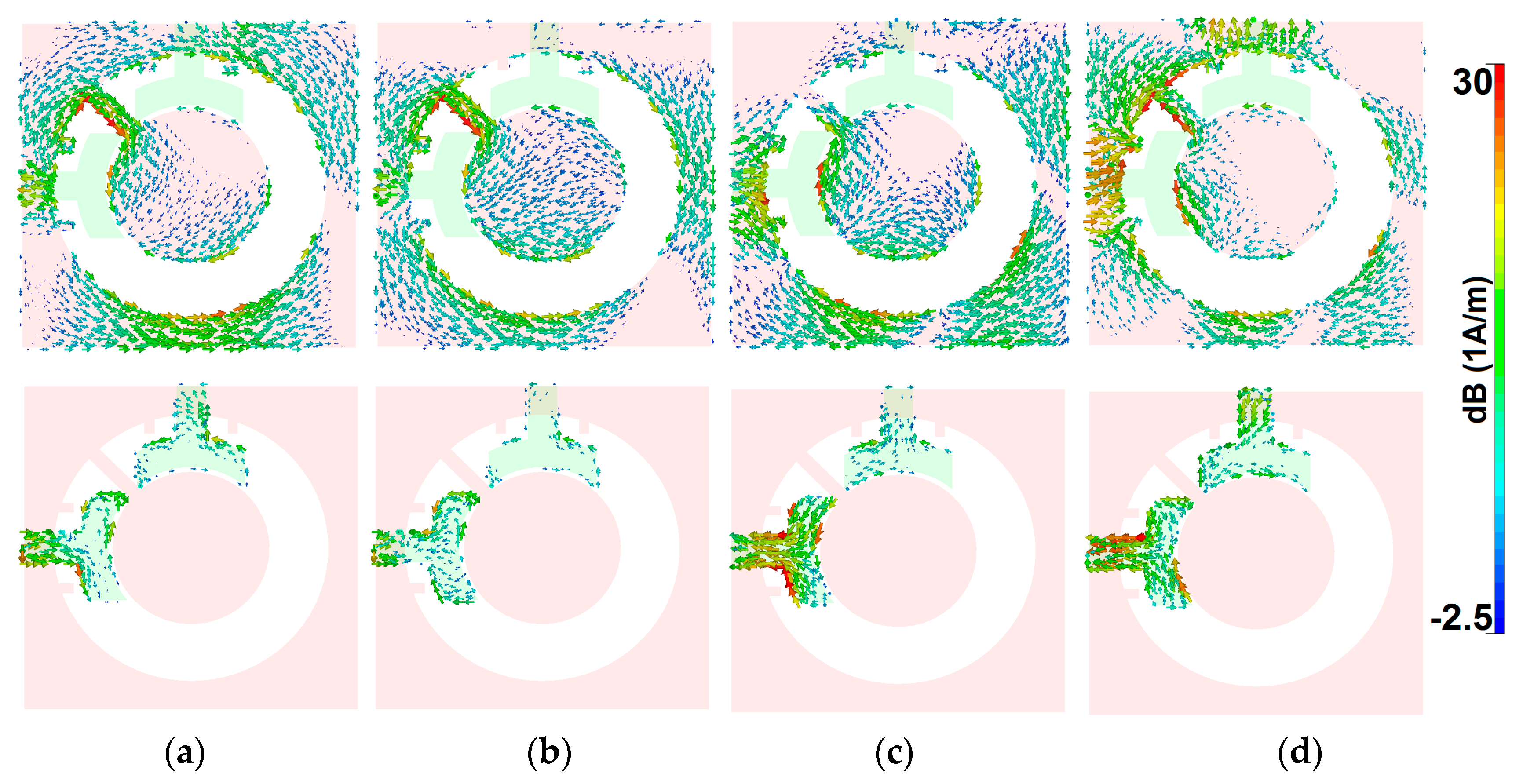

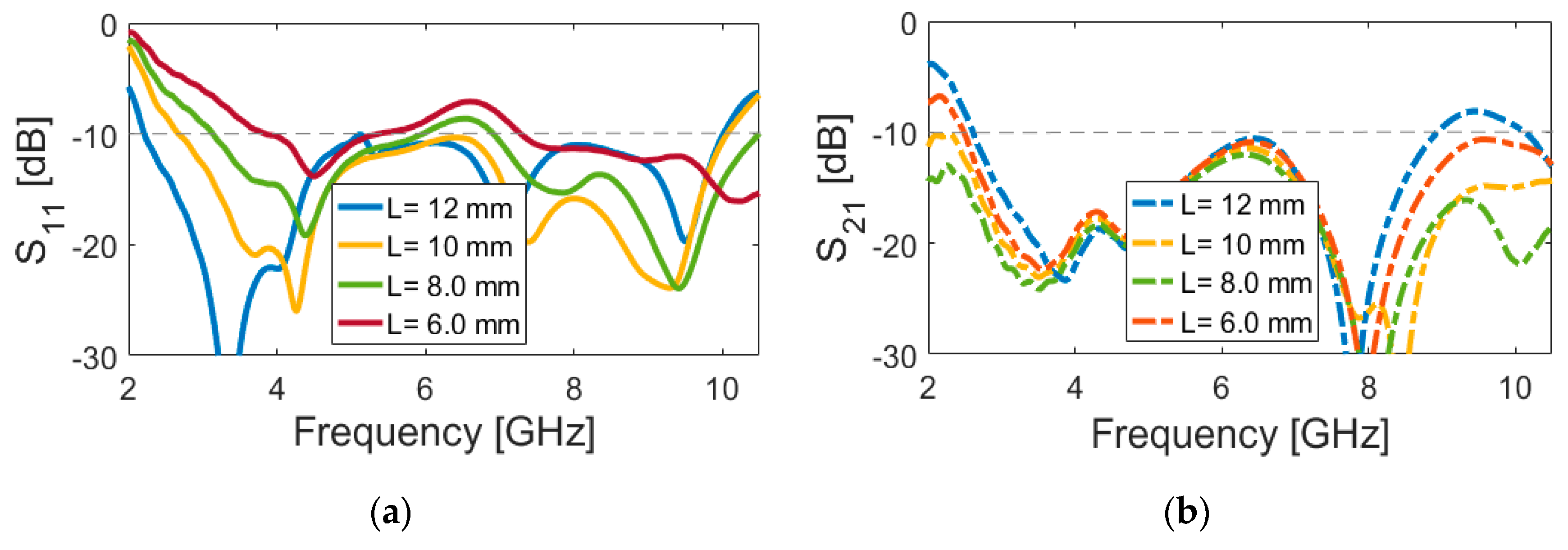

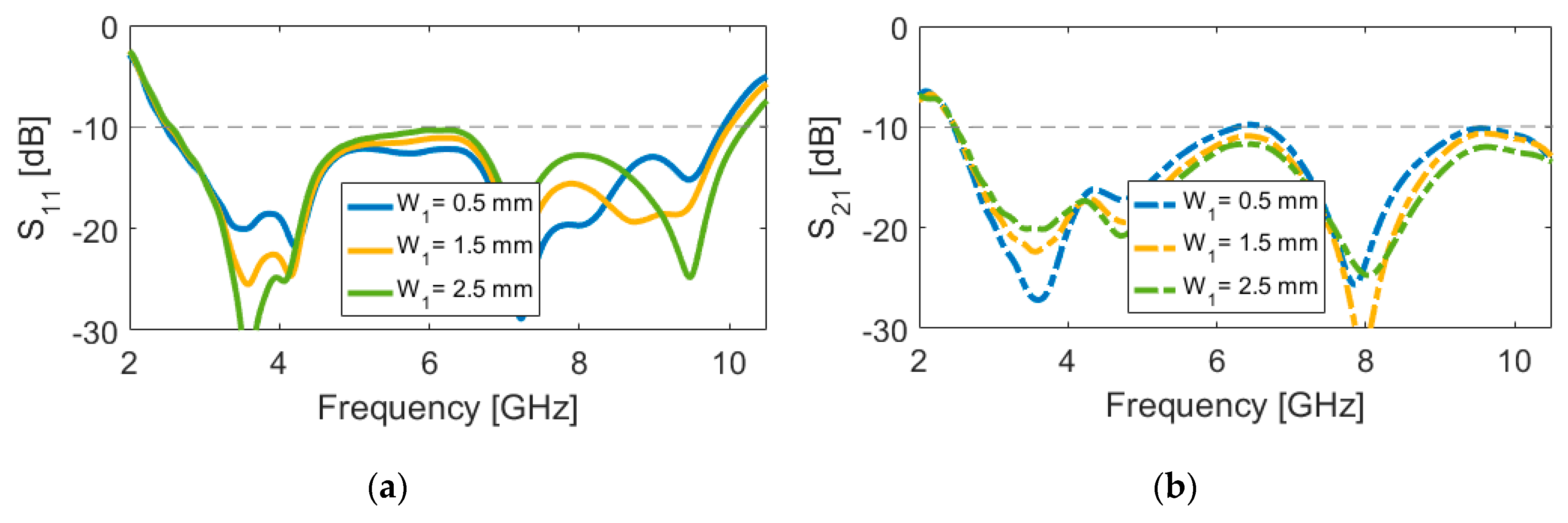
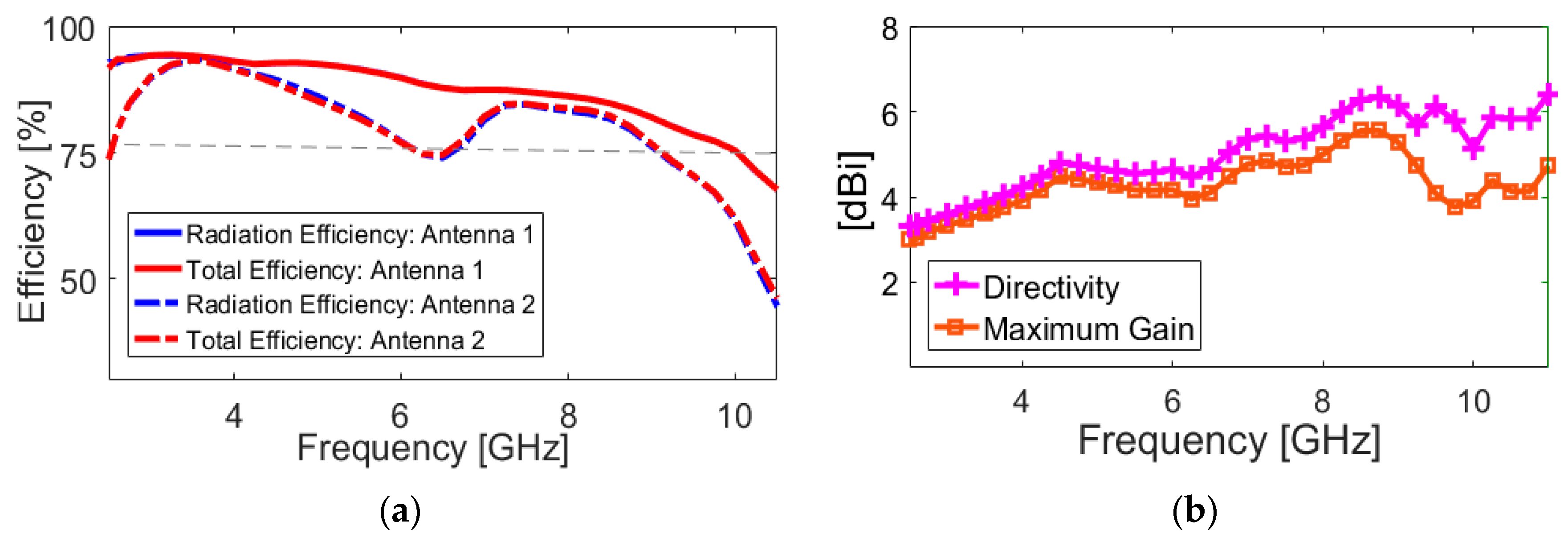


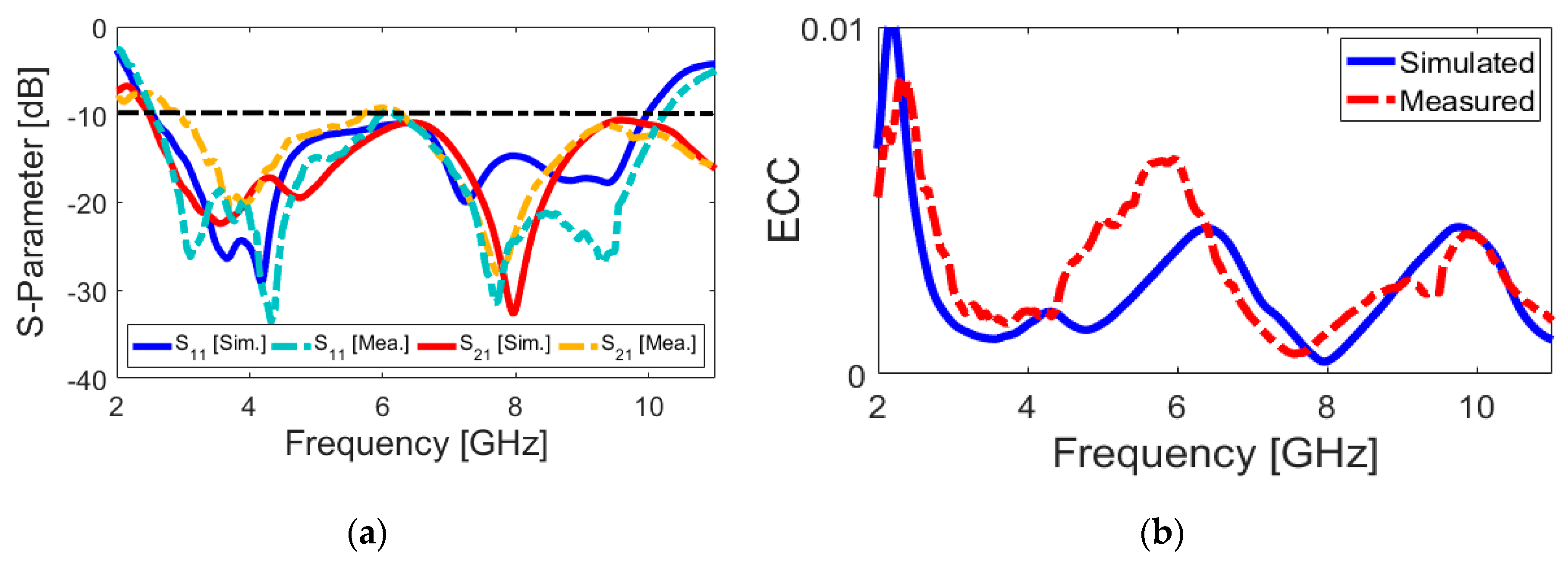
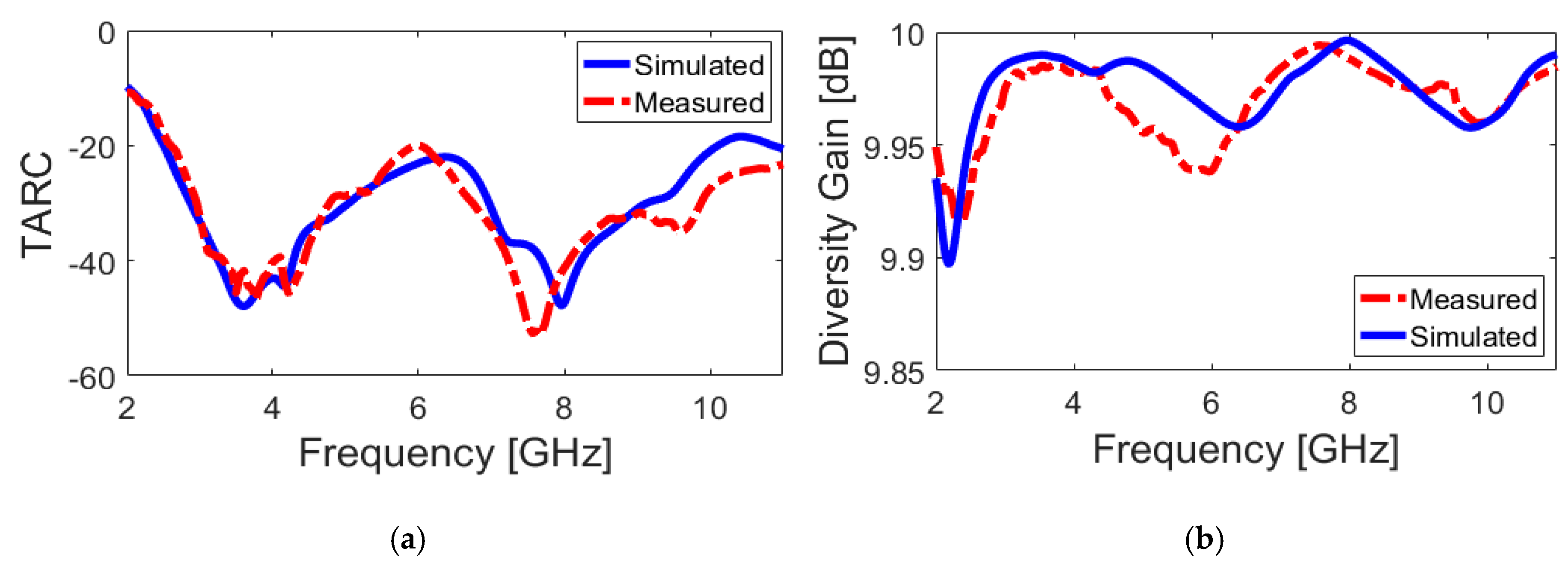
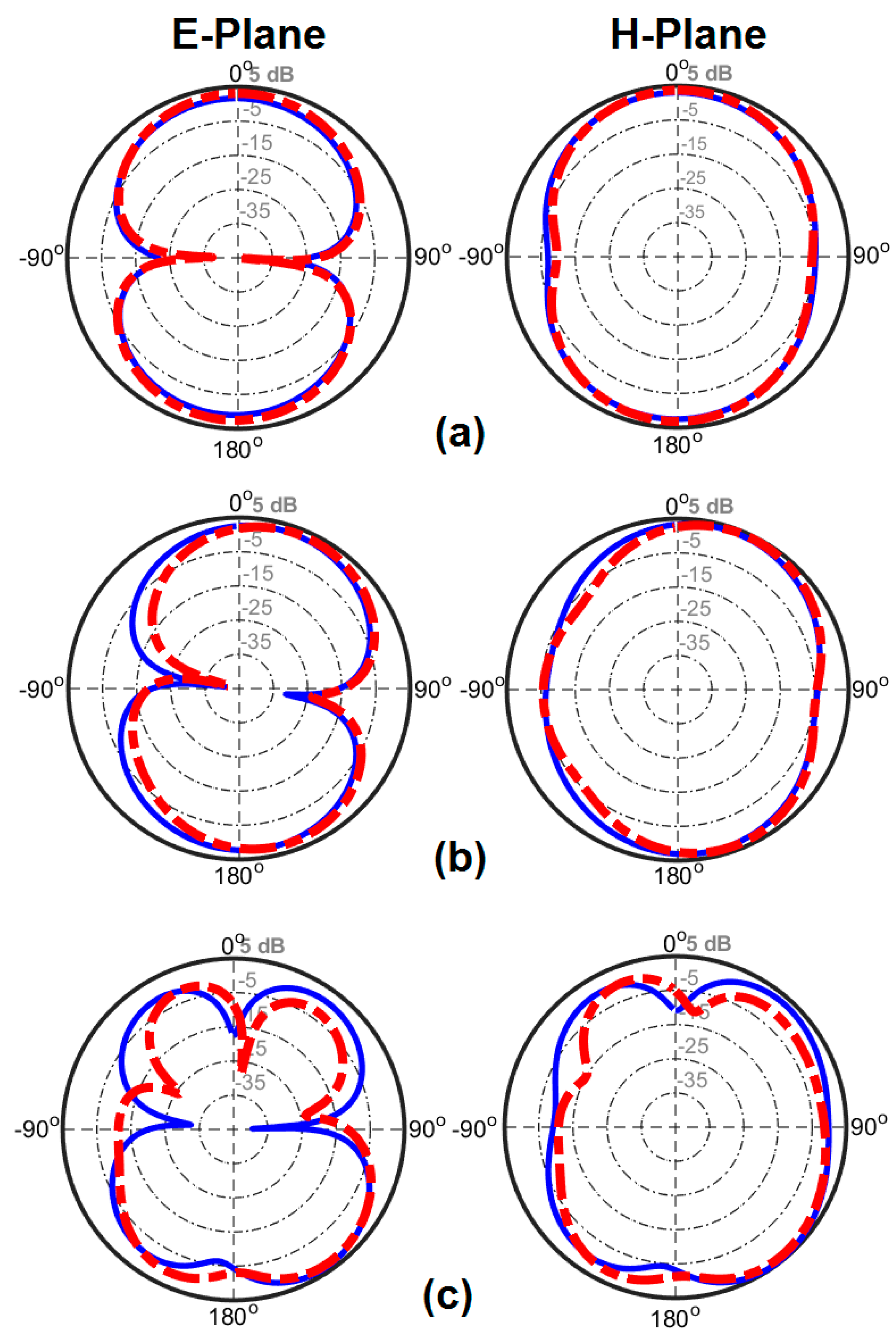

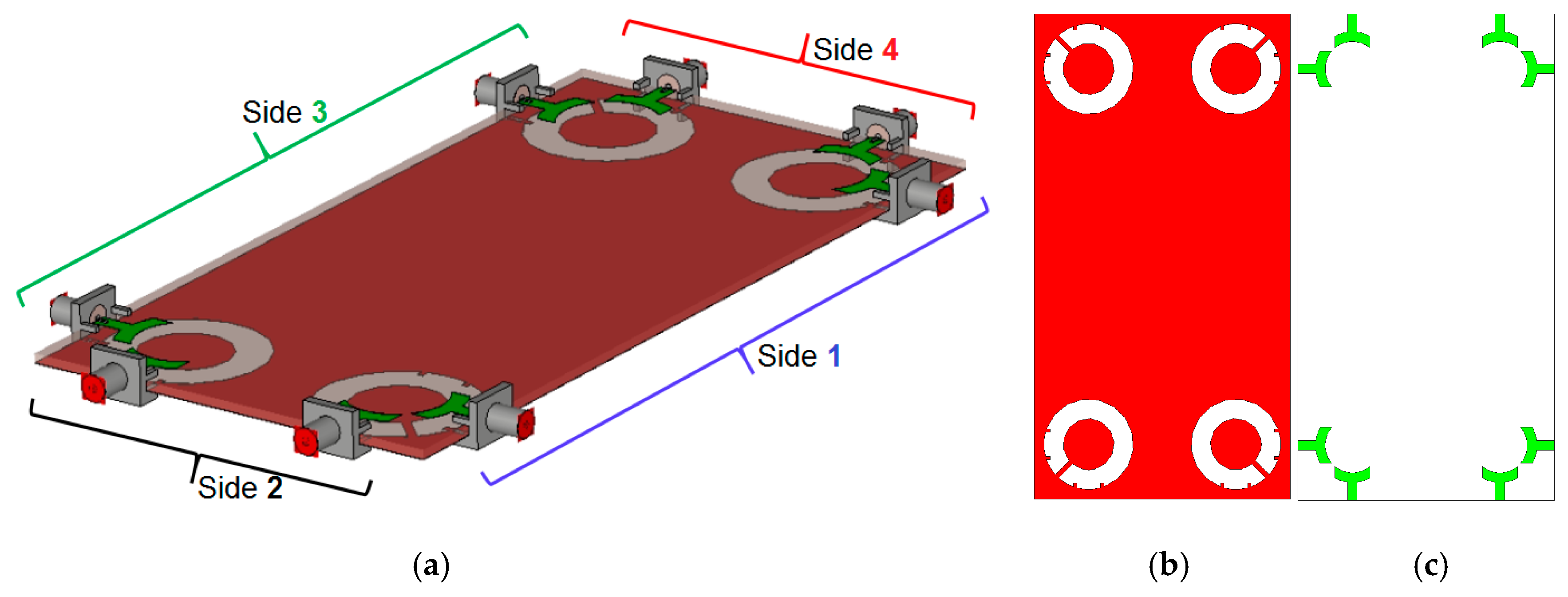

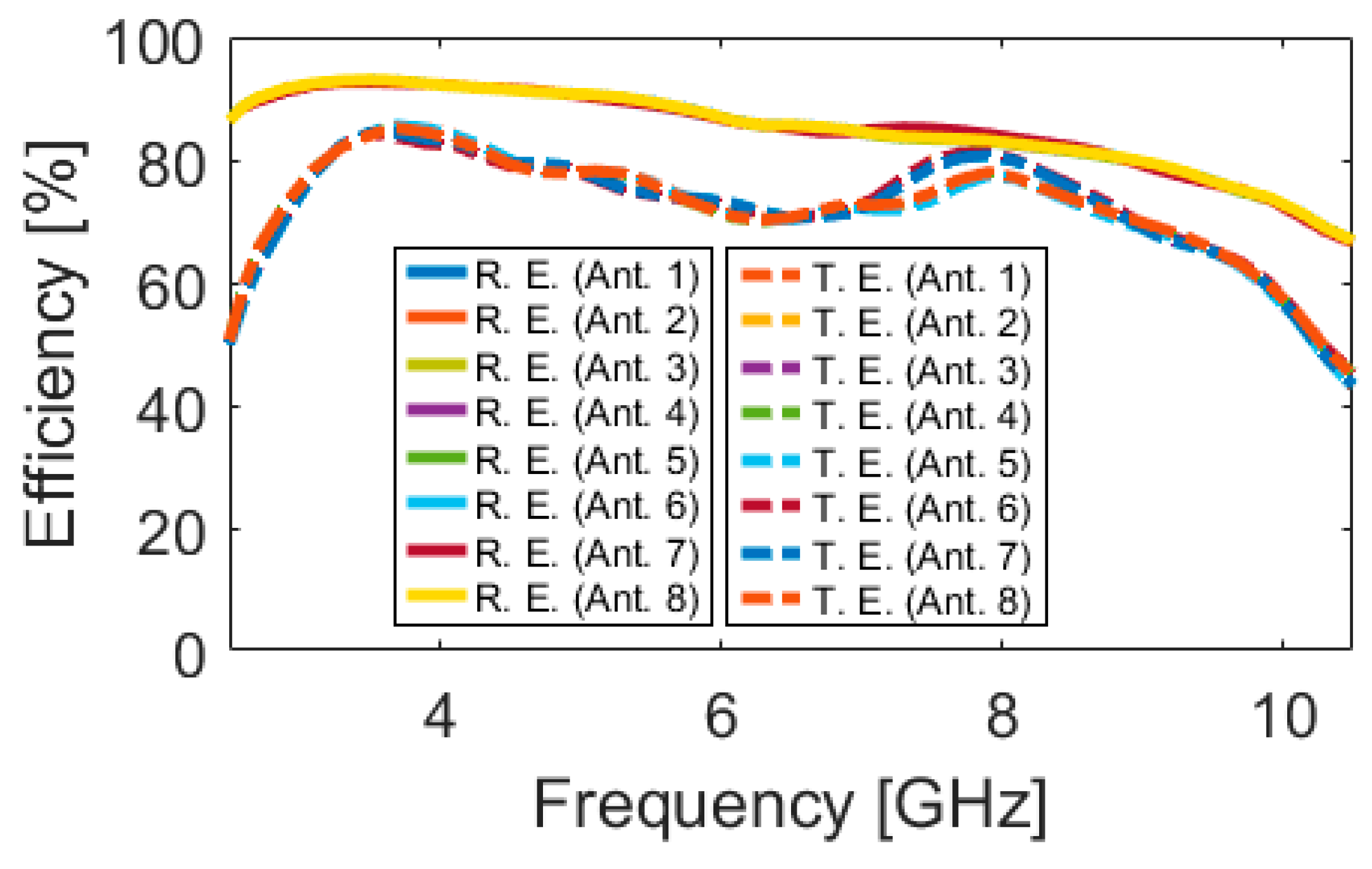
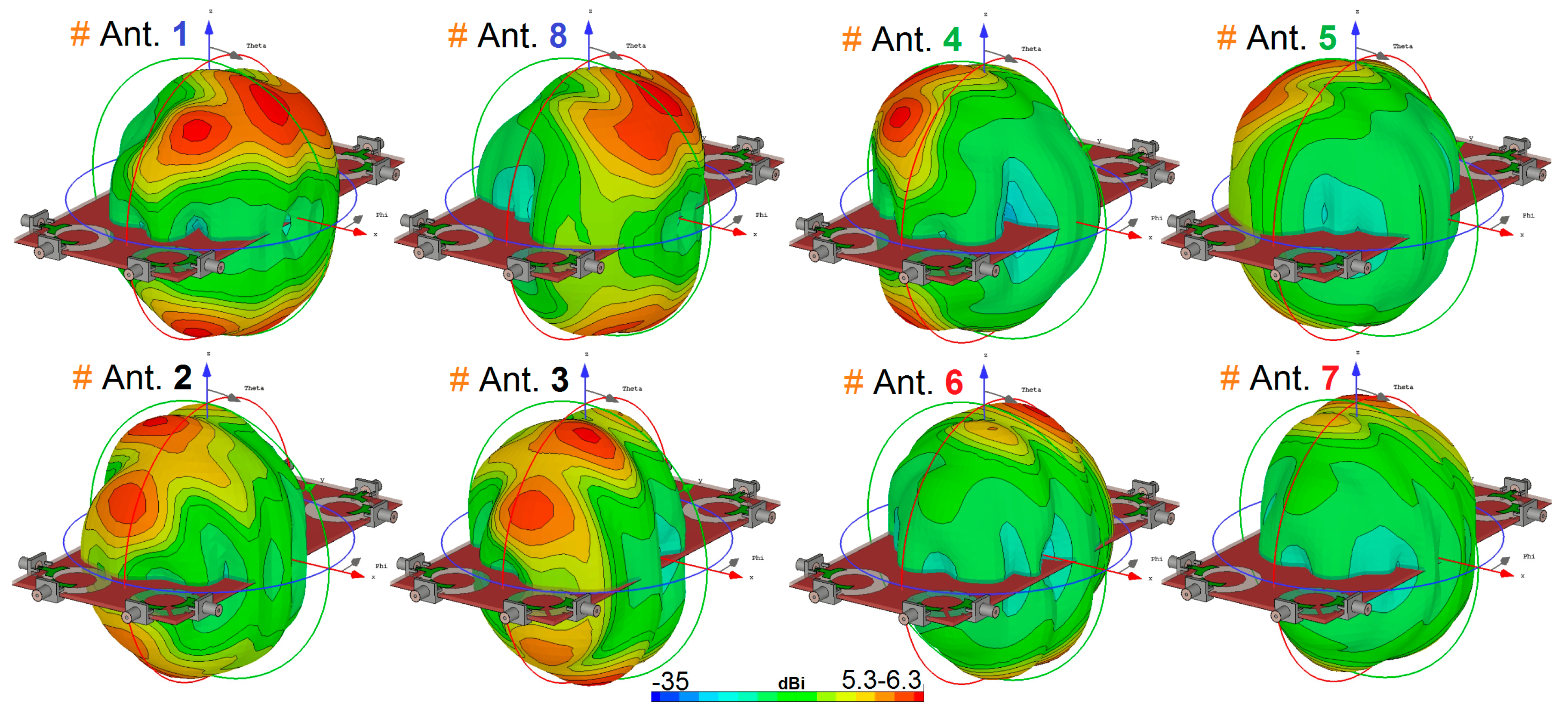
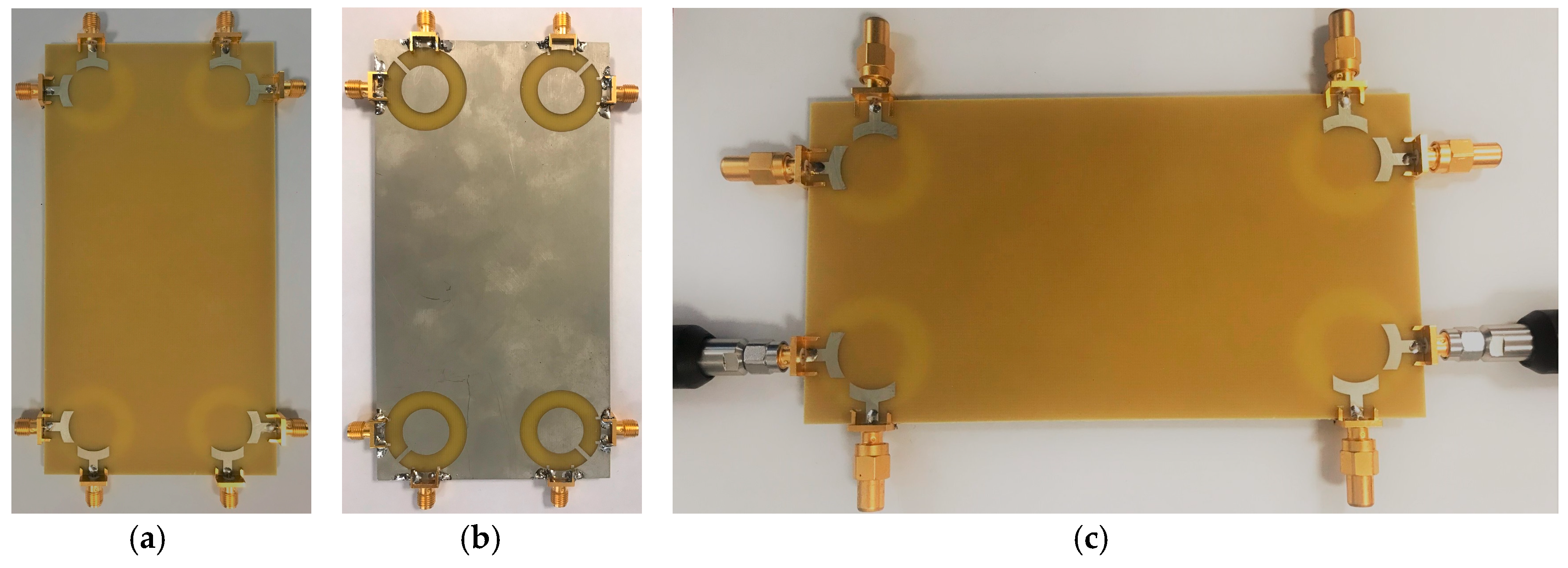



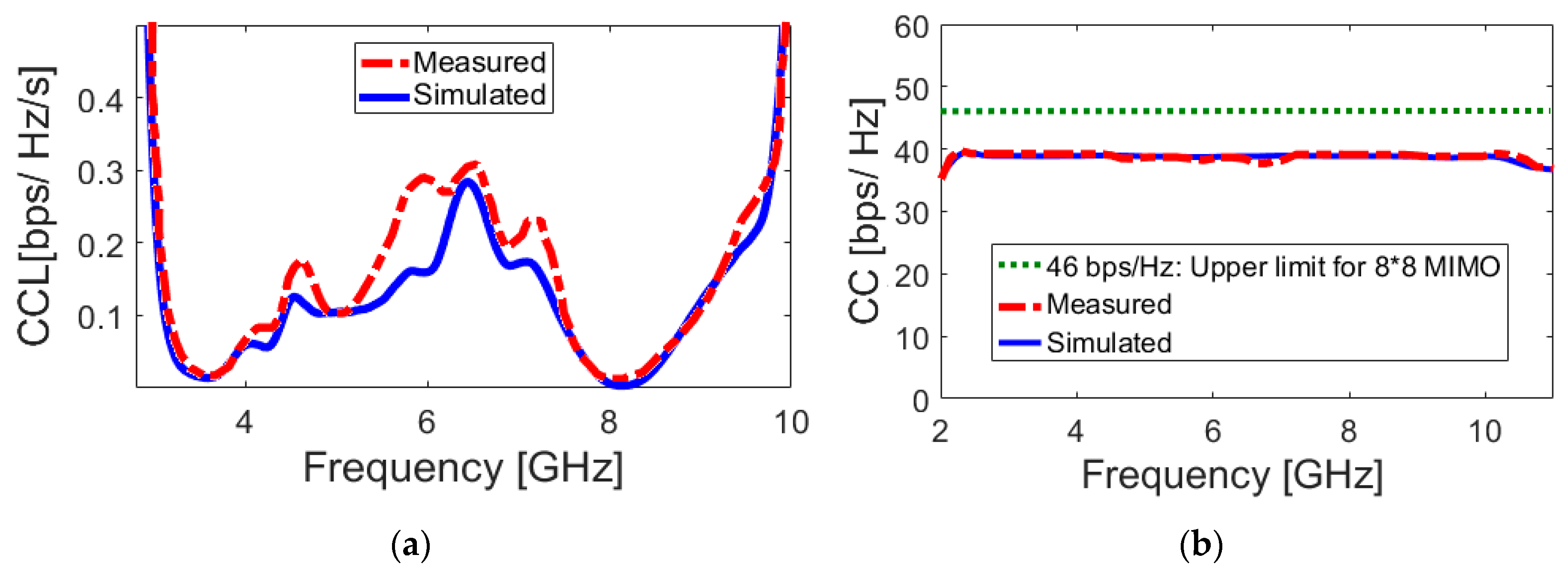
| Parameter | WS | LS | hS | Wf | Lf | d |
|---|---|---|---|---|---|---|
| Value (mm) | 34 | 34 | 1.6 | 5.5 | 3 | 7.5 |
| Parameter | hS | W | L | W1 | L1 | r |
| Value (mm) | 1.6 | 1 | 11 | 1.5 | 1.5 | 11.5 |
| Parameter | r1 | r2 | r3 | Wsub | Lsub | Hsub |
| Value (mm) | 8.5 | 8 | 14 | 75 | 150 | 1.6 |
| Reference | FBW (%) | Size (mm2) | Gain (dB) | ECC |
|---|---|---|---|---|
| [47] | 115% (2.9–11 GHz) | 105 × 105 | 2–7 | - |
| [48] | 112% (3–11.5 GHz) | 90 × 90 | 4–9 | - |
| [49] | 120% (3–12 GHz) | 76.25 × 52.25 | 4–6 | <0.05 |
| [50] | 107% (3–10 GHz) | 72 × 72 | 3–6 | - |
| [51] | 120% (3–12 GHz) | 66.25 × 66.25 | 5 | <0.1 |
| [52] | 112% (3.1–11.8 GHz) | 61 × 68 | 1–7 | <0.02 |
| [53] | 114% (3–11 GHz) | 57 × 57 | 5 | <0.02 |
| [54] | 114% (3–11 GHz) | 56 × 56 | 3–5 | <0.02 |
| [55] | 120% (3–12 GHz) | 40.5 × 40.5 | 5 | <0.1 |
| [56] | 114% (3–11 GHz) | 35 × 35 | 4.6 | <0.3 |
| Proposed Antenna | 121% (2.5–10.2 GHz) | 34 × 34 | 4–6 | <0.01 |
| Ref. | Design Type | B.W. (GHz) | Efficiency (%) | Size (mm2) | ECC |
|---|---|---|---|---|---|
| [21] | Inverted-F | 3.4–3.6 | - | 120 × 70 | - |
| [22] | Monopole | 3.4–3.6 | 35–50 | 150 × 75 | <0.40 |
| [23] | Tightly Arranged Pairs | 3.4–3.6 | 50–70 | 150 × 73 | <0.07 |
| [24] | Integrated Waveguide | 3.4–3.6 | 50–80 | 150 × 75 | <0.2 |
| [25] | Modified PIFA | 3.25–3.85 | 40–75 | 150 × 75 | <0.01 |
| [26] | Loop | 2.55–2.6 | 48–63 | 136 × 68 | <0.15 |
| [27] | SCS patch-slot | 3.55–3.65 | 52–76 | 150 × 75 | - |
| [28] | Monopole-Slot | 2.55–2.68 | 48–63 | 136 × 68 | <0.15 |
| [29] | Slot | 3.4–3.8 | 50–75 | 150 × 75 | <0.01 |
| [30] | circular-slot loop | 3.3–3.9 | 60–80 | 150 × 75 | <0.01 |
| [31] | Monopole | 4.55–4.75 | 50–70 | 136 × 68 | - |
| [32] | Inverted-F | 3.4–3.6 | 55–60 | 100 × 50 | - |
| [33] | Self-Isolated Monopole | 3.4–3.6 | 60–70 | 150 × 75 | <0.015 |
| [34] | Inverted-L Monopole | 3.3–5 | 40–60 | 136 × 68 | <0.2 |
| [35] | Identical Monopole | 2–6 | 30–60 | 124 × 64 | - |
| [36] | U-Slot | 3.3–6 | 40–75 | 150 × 75 | <0.12 |
| [37] | Loop | 3.3–5 | 40–70 | 150 × 75 | <0.1 |
| [38] | Inverted-F | 3.3–4.5 | 20–75 | 150 × 75 | <0.6 |
| This Work | Diversity Ring-Slot | 2.6–10.2 (122%) | 60–80 | 150 × 75 | <0.007 |
© 2020 by the authors. Licensee MDPI, Basel, Switzerland. This article is an open access article distributed under the terms and conditions of the Creative Commons Attribution (CC BY) license (http://creativecommons.org/licenses/by/4.0/).
Share and Cite
Ojaroudi Parchin, N.; Jahanbakhsh Basherlou, H.; I. A. Al-Yasir, Y.; M. Abdulkhaleq, A.; A. Abd-Alhameed, R. Ultra-Wideband Diversity MIMO Antenna System for Future Mobile Handsets. Sensors 2020, 20, 2371. https://doi.org/10.3390/s20082371
Ojaroudi Parchin N, Jahanbakhsh Basherlou H, I. A. Al-Yasir Y, M. Abdulkhaleq A, A. Abd-Alhameed R. Ultra-Wideband Diversity MIMO Antenna System for Future Mobile Handsets. Sensors. 2020; 20(8):2371. https://doi.org/10.3390/s20082371
Chicago/Turabian StyleOjaroudi Parchin, Naser, Haleh Jahanbakhsh Basherlou, Yasir I. A. Al-Yasir, Ahmed M. Abdulkhaleq, and Raed A. Abd-Alhameed. 2020. "Ultra-Wideband Diversity MIMO Antenna System for Future Mobile Handsets" Sensors 20, no. 8: 2371. https://doi.org/10.3390/s20082371
APA StyleOjaroudi Parchin, N., Jahanbakhsh Basherlou, H., I. A. Al-Yasir, Y., M. Abdulkhaleq, A., & A. Abd-Alhameed, R. (2020). Ultra-Wideband Diversity MIMO Antenna System for Future Mobile Handsets. Sensors, 20(8), 2371. https://doi.org/10.3390/s20082371









